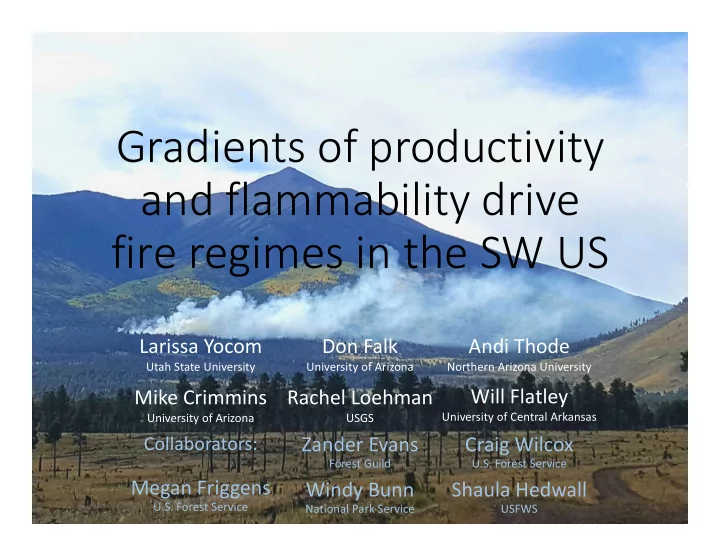

Gradients � of � productivity � and � flammability � drive � fire � regimes � in � the � SW � US Larissa � Yocom Don � Falk Andi � Thode Utah � State � University University � of � Arizona Northern � Arizona � University Will � Flatley Mike � Crimmins Rachel � Loehman University � of � Central � Arkansas University � of � Arizona USGS Collaborators: Zander � Evans Craig � Wilcox Forest � Guild U.S. � Forest � Service Megan � Friggens Windy � Bunn Shaula � Hedwall U.S. � Forest � Service National � Park � Service USFWS
Fire � regime � controls: � climate, � ignitions, � vegetation Figure: � Moritz, � Hessburg and � Povak in � McKenzie � et � al. � 2011
Climate & � vegetation are � changing Hoerling et � al. � 2013
Climate & � vegetation are � changing Cayan et � al. � 2013 C.D. � Allen � in � McDowell � & � Allen � 2015 Hoerling et � al. � 2013
Vegetation � and � fire � regimes � vary � along � elevation � gradients Flammability � limitation High � fuel moisture Low � fuel � mass & � continuity Fuel � limitation Merriam’s � Life � Zones Fire � frequency Historical Peak � in fire � frequency Elevation Elevation
Questions • Do � we � see � this � curve � in � available � data? • What � is � likely � to � happen � to � fire � activity � in � the � future? � Historical Future? Fire � frequency Elevation
Study � area At � 1,539,393 � randomly � located � points, � we � extracted: • Elevation � (Landfire) • Vegetation: � BioPhysical Setting � (Landfire) • Net � Primary � Productivity � (NTSG) • Climate � (Gridmet & � MACA) • Historical � fire � frequency � & � severity � (Landfire)
MAP, � MAT, � VPD � ƒ elevation Precipitation � (mm) Temperature � (°C) VPD � (kPa) Elevation Elevation Elevation
NPP � ƒ MAP, � MAT, � VPD NPP � (kg � C � / � m 2 Elevation Precipitation Temperature VPD
Vegetation � types � ƒ elevation, � climate Mixed � con Ponderosa Woodland Shrub Grass Desert � grass Fuel � Fuel � Scrub limitation limitation NPP Precipitation Elevation Mixed � con Flammability � Flammability � limitation limitation Ponderosa Woodland Shrub Grass Desert � grass Scrub Temperature VPD
Fire � frequency � & � severity � reflect � interactions � of � fuel � productivity � & � flammability MFRI MFRI MFRI Elevation Precipitation Temperature VPD NPP % � High � Sev % � High � Sev % � High � Sev Elevation Precipitation Temperature VPD NPP
Projected � changes � in � climate � are � variable � across � the � elevation � gradient • RCP � 8.5 � scenario, � 2040 � 2069 � vs. � 1981 � 2010 �� in � Precipitation �� in � Temperature �� in � VPD Elevation Elevation Elevation
Projected � changes � by � vegetation � class RCP � 8.5 � scenario, � 2040 � 2069 � vs. � 1981 � 2010 Mixed � conifer Ponderosa CHANGE Woodland Shrub Grass Desert � grass Scrub �� Precipitation �� Temperature �� VPD Mixed � conifer Ponderosa % � CHANGE Woodland Shrub Grass Desert � grass Scrub % �� Precipitation % �� Temperature % �� VPD
Projected � % � change � in � climate � variables RCP8.5, � 1981 � 2010 � to � 2040 � 2069 Temperature Precipitation VPD Data � from � MACA; � Abatzoglou and � Brown � 2011
Projected � % � change � in � climate � variables RCP8.5, � 1981 � 2010 � to � 2040 � 2069 Temperature Precipitation VPD Data � from � MACA; � Abatzoglou and � Brown � 2011
Caveats • We � focused � on � historical � fire � frequency; � frequency � has � already � changed • Historical � fire � frequency � still � represents � fire � potential, � because � of � the � crossing � of � the � two � fire � limitation � gradients � (fuel � load/continuity � & � flammability) • Also: � a � confounding � factor � of � legacy � fuels � from � suppression � era
Conclusions • Some � thoughts • Lowest � elevations: � greatest � absolute � change • Highest � elevations: � greatest � % � change • Some � parts � of � the � gradient � have � tighter � relationships � no � wiggle � room? • Other � places � on � the � gradient � have � wide � variability � room � for � flexibility? • If � more � precip in � low � elevation � places: � they � stop � being � fuels � limited • If � higher � temps � in � high � elevation � places: � they � stop � being � flammability � limited • Place � based � analyses � are � critical; � incorporate � feedbacks • Question: � At � what � scale � can � we � safely � generalize � about � trends � and � forecasts?
Thank � you Funding: � Joint � Fire � Science � Program
Recommend
More recommend